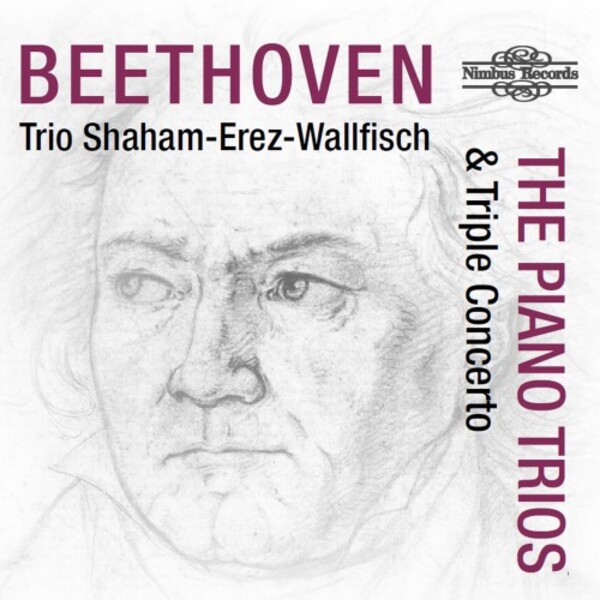BEETHOVEN Piano Trios and Triple Concerto
View record and artist detailsRecord and Artist Details
Genre:
Chamber
Label: Nimbus
Magazine Review Date: 04/2025
Media Format: CD or Download
Media Runtime: 282
Mastering:
DDD
Catalogue Number: NI1709

Tracks:
| Composition | Artist Credit |
|---|---|
| Piano Trios, Movement: No. 9 in B flat, WoO39 |
Ludwig van Beethoven, Composer
Trio Shaham Erez Wallfisch |
| Piano Trios, Movement: No. 1 in E flat, Op. 1/1 |
Ludwig van Beethoven, Composer
Trio Shaham Erez Wallfisch |
| Piano Trios, Movement: No. 5 in D, Op. 70/1, 'Ghost' |
Ludwig van Beethoven, Composer
Trio Shaham Erez Wallfisch |
| Piano Trios, Movement: No. 2 in G, Op. 1/2 |
Ludwig van Beethoven, Composer
Trio Shaham Erez Wallfisch |
| Piano Trios, Movement: No. 4 in B flat, Op. 11 (clarinet (or violin), piano and cello) |
Ludwig van Beethoven, Composer
Trio Shaham Erez Wallfisch |
| Piano Trios, Movement: No. 11 in G, Op. 121a (Kakadu Variations) |
Ludwig van Beethoven, Composer
Trio Shaham Erez Wallfisch |
| Piano Trios, Movement: No. 3 in C minor, Op. 1/3 |
Ludwig van Beethoven, Composer
Trio Shaham Erez Wallfisch |
| Piano Trios, Movement: No. 6 in E flat, Op. 70/2 |
Ludwig van Beethoven, Composer
Trio Shaham Erez Wallfisch |
| Piano Trios, Movement: No. 7 in B flat, Op. 97, 'Archduke' |
Ludwig van Beethoven, Composer
Trio Shaham Erez Wallfisch |
| Concerto for Violin, Cello, Piano and Orchestra |
Ludwig van Beethoven, Composer
Eckehard Stier, Conductor Orchestra of the Swan Trio Shaham Erez Wallfisch |
Author: Richard Wigmore
The line-up bodes well. And there’s certainly some fine playing here from these three seasoned practitioners. Yet for my taste something vital is missing, especially in the Op 1 trilogy. This is the music of a young man exulting in his own pianistic and compositional virtuosity. Trio Shaham-Erez-Wallfisch take a predominantly relaxed, amiable view of Nos 1 and 2, with the strings savouring their opportunities for cantabile lyricism. But caution seems to rule, at the expense of the 20-something Beethoven’s wit and devilry. With close recording of the piano and violin (the cello is set rather further back) a true pianissimo is at a premium. Nowhere do I sense the spirit of gleeful improvisation caught by the Sitkovetsky, Wanderer and Florestan Trios. The Scherzo of No 2 here jogs pleasantly enough. With the Florestan and Wanderer especially, it becomes a fizzing jeu d’esprit guaranteed to provoke a smile. For all the finesse of the Trio Shaham-Erez-Wallfisch, both Presto finales sound too measured. At the 1795 premiere the hilarious finale of No 1 provoked wild applause. In the Florestan’s whooping, high-kicking performance you can hear why.
In the C minor, Op 1 No 3, Shaham and co tend to emphasise lyrical warmth over explosive violence. Shaham’s sweet, rather old-school vibrato brings a distinctive flavour to Beethoven’s cantabile themes. They distil a wistful elegance in the Minuet where other groups are faster and edgier. But the outer movements lack rhythmic tension. Beethoven’s Prestissimo marking in the finale is an invitation to go for broke. Not for Trio Shaham-Erez-Wallfisch, who alongside the smouldering rival performances sound simply too careful.
Impressions are broadly similar in Op 11 (originally written for clarinet, cello and piano) and the three later masterpieces. The famous ‘Ghost’ centrepiece of Op 70 No 1 is finely sustained but sounds more tragic than spectral – a valid alternative, perhaps, to the Florestan’s stark, disembodied performance. Elsewhere moments that linger in the memory include Wallfisch’s Romantically intense solo in the Adagio of Op 11, the refined dovetailing in the Scherzo of the Archduke (here shorn of its long repeat) and the unusually reflective performance of the Allegretto non troppo of Op 70 No 2. Where the lighter, fleeter Florestan place this music somewhere between Mozart and Schubert, Shaham and colleagues evoke a Brahmsian intermezzo. The strings’ expressive warmth comes into its own in the Andante cantabile of the Archduke, Beethoven’s most luxuriant set of variations. Here, though, I specially enjoy the more mobile performance from the Florestan, who take note of the composer’s ma però con moto and give the staccato second variation a puckish delicacy.
Heeding Beethoven’s moderato qualification, Trio Shaham-Erez-Wallfisch balance breadth and lyrical tenderness in the opening Allegro of the Archduke. But even after repeated hearings I find it hard to adjust to their easy-going tempos in the Op 70 trios. The combustible first movement of the Ghost seems to proceed bar by bar where it should surge rampantly, while the opening Allegro of No 2, non troppo with a vengeance, quite lacks the dancing lightness conjured by the rival versions.
While their playing is accomplished, often lyrically eloquent, Shaham and co too often plane Beethoven’s rough, dangerous edges to be wholly satisfying. The Triple Concerto, still undervalued, leaves a similar impression. While Wallfisch’s eloquent sotto voce solos in the Largo and finale are moments to savour, this is a robust rather than specially revealing performance. For poetry and subtlety of nuance go for Pierre-Laurent Aimard, Thomas Zehetmair and Clemens Hagen, with Harnoncourt, or the delightfully fresh period-instrument version from Isabelle Faust, Jean-Guihen Queyras and Alexander Melnikov, with the Freiburg Baroque Orchestra.
Discover the world's largest classical music catalogue with Presto Music.

Gramophone Digital Club
- Digital Edition
- Digital Archive
- Reviews Database
- Full website access
From £8.75 / month
Subscribe
Gramophone Full Club
- Print Edition
- Digital Edition
- Digital Archive
- Reviews Database
- Full website access
From £11.00 / month
Subscribe
If you are a library, university or other organisation that would be interested in an institutional subscription to Gramophone please click here for further information.




